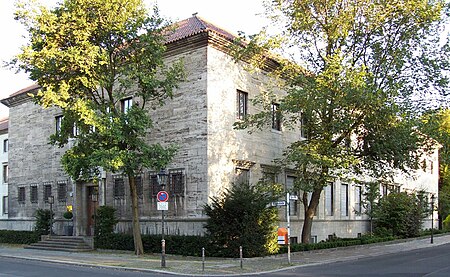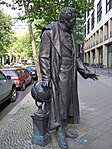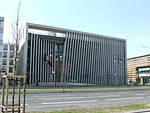Building of the Yugoslavian legation in Berlin

The Building of the Yugoslavian Legation in Berlin' was built from 1938 to 1940 for the diplomatic representation of the Kingdom of Yugoslavia in the German Empire. The building designed by Werner March is located at Rauchstraße 17-18 in the Botschaftsviertel of the Tiergarten district and is a listed building. There were two historical buildings on the site. Villa Kabrun was built in 1865-1867 by the architects Ende & Böckmann on behalf of the manufacturer and manor owner August Kabrun (1807-1877) and his wife Flora Luise Henriette Nicolovius (1811-1879), a grandniece of Johann Wolfgang Goethe. Kabrun's grandson, Ulrich Graf Brockdorff-Rantzau, became the first Foreign Minister of the Weimar Republic. Kabrun's daughters, Cäcilie von Brockdorff and her sister Cornelia von Stralendorff, sold the villa to the merchant Martin Levy, who lived there until 1911. The later banker Arthur Salomonsohn, who was related to Martin Levy through his mother Ernestine Levy, also lived there as a child. The heirs, including the professor of economics Hermann Levy, transferred the property in 1925 to the chemist and industrialist Paul Mendelssohn Bartholdy, who had the Villa Mendelssohn Bartholdy built on it. In 1938, the Mendelssohn Bartholdy family, which was persecuted as Jewish, was expropriated by the Reich authorities through expropriation and had to emigrate. A new building for the Royal Yugoslavian Legation was erected on the site because Albert Speer's plans for a World Capital Germania at the old seat of the legation included the total demolition in favor of the new headquarters of the Oberkommando des Heeres (OKH) at the old headquarters. The Yugoslavian legation moved into the building in October 1940, but only used it for six months. With the Wehrmacht attack on Yugoslavia in April 1941, the Yugoslav state was destroyed and there was no longer any need for a diplomatic mission. After an interim use by Alfred Rosenberg as Reich Minister for the Occupied Eastern Territories, Werner March began converting it into a guest house of the Großdeutsches Reich in 1942. After the end of the Second World War in 1945, the People's Republic of Yugoslavia used the building as the seat of its military mission. In 1953, the Allied Commandant's Office established the Supreme Restitution Court for Berlin (ORG). The ORG was the court of last resort for lawsuits for restitution of assets to racially and politically persecuted persons. The Mendelssohn Bartholdy family also filed an action for Restitution of their assets, including the property of the ORG, which thus had to decide on the rightful owner of the house they had used themselves, and upheld the action. The ORG existed until the end of the Four Power Status through Reunification in 1990. Since 1999, the German Council on Foreign Relations (DGAP) has been using the building.
Excerpt from the Wikipedia article Building of the Yugoslavian legation in Berlin (License: CC BY-SA 3.0, Authors, Images).Building of the Yugoslavian legation in Berlin
Rauchstraße, Berlin Tiergarten
Geographical coordinates (GPS) Address External links Nearby Places Show on map
Geographical coordinates (GPS)
| Latitude | Longitude |
|---|---|
| N 52.508673 ° | E 13.346341 ° |
Address
Rauchstraße 17
10787 Berlin, Tiergarten
Germany
Open on Google Maps









